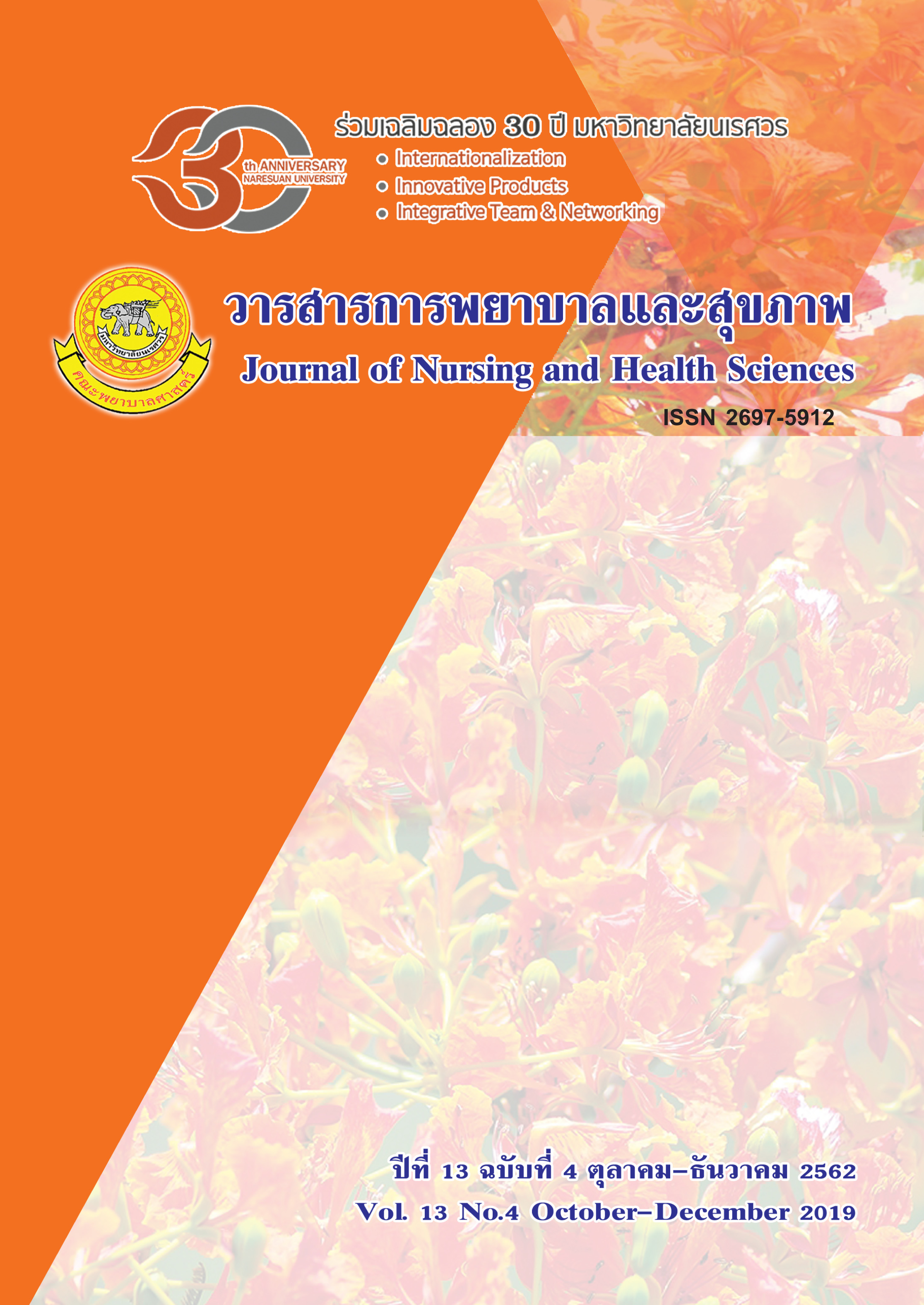Relationship between Symptom Severity and Distress in Patients with Advanced Cancer
Main Article Content
Abstract
This descriptive cross-sectional research aimed to investigate symptom severity, distress level, and the correlation between symptomseverity and distress level of patients with advanced cancer. A purposive sample of 428 patients with advanced cancer at OPD and IPD were recruited for this study. The instruments used to collect data were comprised ofpersonal information sheet, ESAS (Edmonton Symptom Assessment Scale), and distress thermometer. Data were analyzed by using descriptive statistics, and Spearman rank correlation.Findings showed that patients with advanced cancer perceived distress at a moderate level (Mean = 4.08, SD = 2.34). The problems listedmost were physical problems, emotional problems, and practical problems. The top five symptomsreported include fatigue, not well-being, pain,poor appetite,and anxiety. Severity of symptoms were significantly positively correlated with distress of patients with advanced cancer (p < .001). It is suggested that patients with advanced cancer should be assessed of symptom severity and distress in order to be provided with proper care.
Article Details
References
American Cancer Society. (2014). Advanced cancer. Retrieved 9 November 2016 from https://www.cancer.org/acs/ groups/cid/ documents/webcontent/003082-pdf.pdf
Bradley, N., Davis, L., & Chow, E. (2005). Symptom distress in patients attending an outpatient palliative radiotherapy clinic. Journal of Pain and Symptom Management, 30(2), 123–31. DOI: 10.1016/j.jpainsymman.2005.02.015
Bruera, E., Kuehn, N., Miller, M.J., Selmser, P., & Macmillan, K. (1991). The edmonton symptom assessment system (ESAS): A simple method for the assessment of palliative care patients. Journal of Palliative Care, 7(2), 6-9.
Chinda, M., Jaturapatporn, D., Kirshen, A.J., & Udomsubpayakul, U. (2011). Reliability and validity of a Thai version of the edmonton symptom assessment scale (ESAS-Thai). Journal of Pain and Symptom Management, 42(6), 954-960. doi: 10.1016/j.jpainsymman.2011.02.020
Delgado G.M., Parsons, H.A., Li, Z., Palmer, J.L., & Bruera, E. (2009). Symptom distress in advanced cancer patients with anxiety and depression in the palliative care setting. Support Care Cancer, 17(5), 573-579. doi: 10.1007/s00520-008-0529-7
Holland, J.C., & Alici, Y. (2010). Management of distress in cancer patients. Journal of Supportive Oncology, 8(1), 4–12.
Hui, D., & Bruera, E. (2017). The Edmonton Symptom Assessment System 25 years later. Past, present and future development. Journal of Pain and Symptom Management, 53(3), 630-643.
Kirkova, J., Walsh, D., Rybicki, L., Davis, M.P., Aktas, A., Jin, T., ...Homsi, J. (2010). Symptom severity and distress in advanced cancer. Palliative Medicine, 24(3), 330–339. doi: 10.1177/0269216309356380
Lagman, L.R., Davis, P.M., Legrand, B.S., & Walsh, D. (2005).Common symptoms in advanced cancer. Surgical Clinics of North America, 85, 237–255. doi: 10.1016/j.suc.2004.11.004
Lancker, V.A., Velghe, A., Hecke, V.A., Verbrugghe, M., Noortgate, V.N., & Grypdonck, M., (2013). Prevalence of symptoms in older cancer patients receiving palliative care: A systematic review and meta –analysis. Journal of Pain and Symptom Management, 47(1), 90–104.
Laurujisawat, P. & Jetiyanuwat, S. (2013). Validity of the Thai version of the distress thermometer. Journal of the Psychiatric Association of Thailand, 3, 257-270. [In Thai].
Lavdaniti, M., Fradelos, E.C., Troxoutsou, K., Zioga, E., Mitsi, D., Alikari, V., ...Zyga, S. (2018). Symptoms in advanced cancer patients in Greek hospital: a descriptive study. Asian Pacific Journal of Cancer Prevention, 19(4), 1047-1052. doi: 10.22034/SPJCP.2018.19.4.1047
Lemeshow, S., Hosmer, D.W., Klar, J., & Lwanga, S.K. (1990). Adequacy of sample size in health studies. USA: John Wiley & Sons.
Mehnert, A., Hartung, T.J., Friedrich, M., Vehling, S., Brahler, E., Harter, M., ..., & Faller, H. (2017). One in two cancer patients is significantly distressed: prevalence and indicators of distress. Psycho–Oncology, 27, 75-82. doi: 10.1002/pon.4464
National Comprehensive Cancer Network. (2010). Distress management clinical practice guidelines in oncology. Journal of the National Comprehensive Cancer Network, 8(4), 448–485.
Selby, D., Cascella, A., Gardiner, K., Do, R., Moravan, V., Myers, J., ..., & Chow, E. (2010). A single set of numericalcutpoints to define moderate and severe symptoms for the Edmonton Symptom Assessment System. Journal of Pain and Symptom Management, 39(2), 241-249. doi: 10.1016/jjpainsymman.2009.06.010
Thiagarajan, M., Hsien Chan, C.M., Fuang, H.G., Beng, T.S., Atiliyana, M.A., &Yahaya, N.A. (2016). Symptom prevalence and related distress in cancer patients under chemotherapy. Asian Pacific Journal of Cancer Prevention, 17(1). 171-176. doi: http://dx.doi.org/10.7314/APJCP.2016.17.1.171
Walsh, D., Rybicki, L., Nelson, A.K., & Donnelly, S. (2002). Symptoms and prognosis in advanced cancer. Support Care Cancer, 10, 175-179. doi: 10.1007/s0052-001-0318-z
Wilson, K.G., Chochinov, H.M., McPherson, C.J., LeMay, K., Allard, P., Chary, S., …Fainsinger, R.L. (2007). Suffering with advanced cancer. Journal of Clinical Oncology, 25(13), 1691-1697. doi: 10.1200/JCO.2006.08.6801
Wright, E.P., Kiely, M.A., Lynch, P., Cull, A., & Selby, P.J. (2002). Social problems in oncology. British Journal of Cancer, 87, 1009-1104. doi: 10.1038/sj.bjc.6600642


